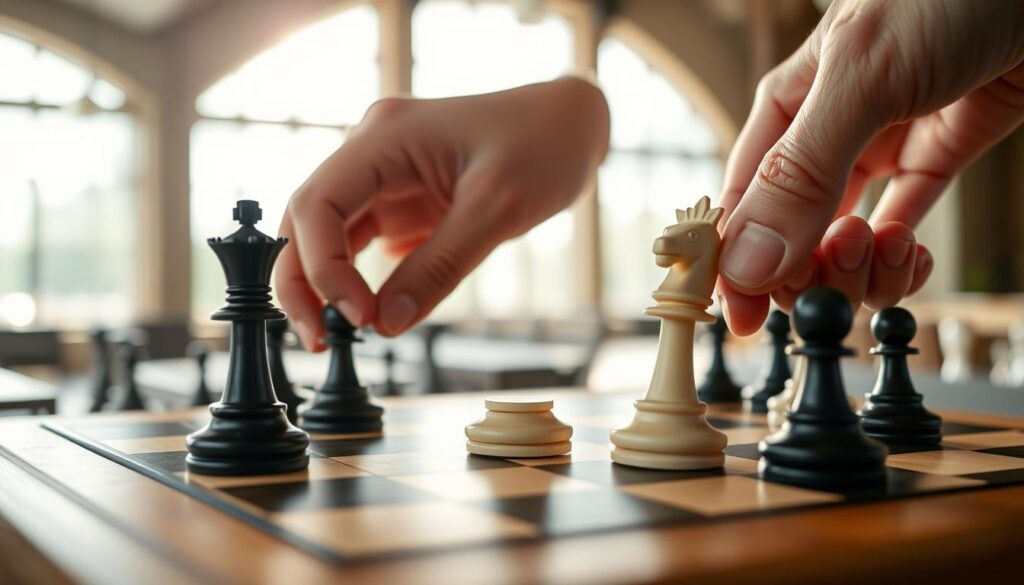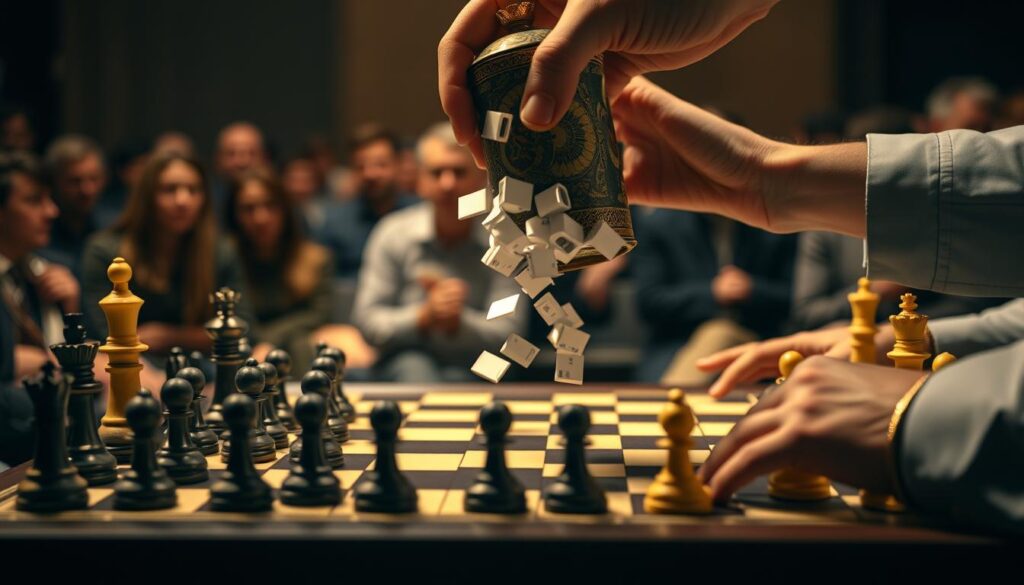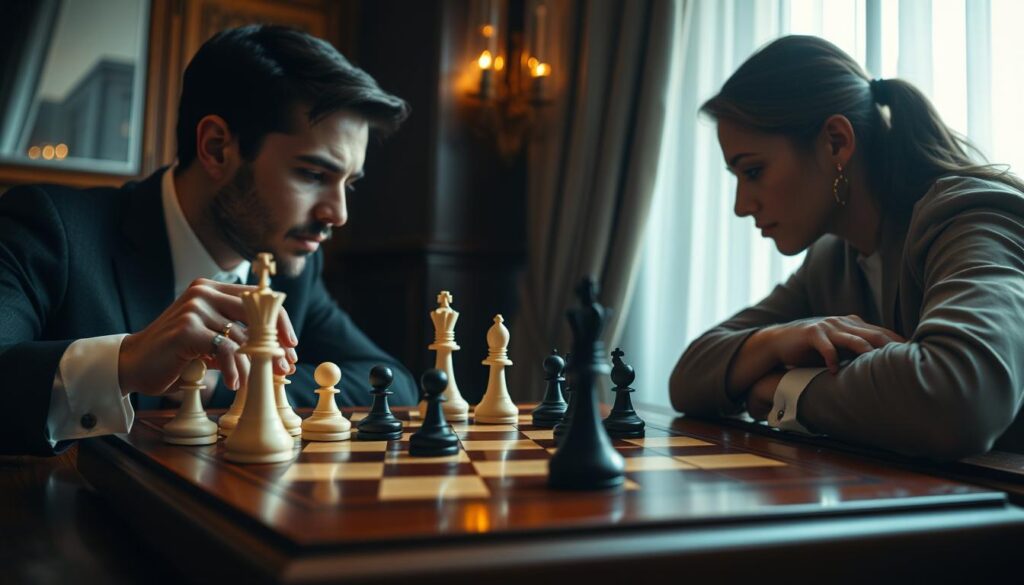Ever wondered how your chess pieces’ color is decided in a tournament? Do you get to choose, or is it decided for you? The color choice in chess is key, and knowing the rules can help you win. As you get ready for your next game, you might wonder how to pick your color. You might also think about the benefits of playing with white or black.
Table of Contents
Understanding Color Selection in Chess Tournaments
Choosing your color in a chess tournament is fascinating. Many think it’s just random, but it’s actually key to winning. In serious games, special software helps pick who plays first.
In long matches, players switch colors. This is true for big games like world championships. Who plays White first is decided by a mix of past results and random draws.
Most tournaments use random draws to pick colors. This could be a coin toss or a computer randomizer. The color you pick can affect your strategy and how you feel during the game.

How to choose color in chess match ?
Here are some important things to know about picking colors in chess tournaments:
- Randomization methods, such as drawing lots or using computer software
- Alternating colors in multi-game matches
- The psychological implications of playing White or Black
- The strategic importance of color choice in chess
Knowing how colors are chosen can help players get ready for tournaments. It can also make their game strategy better.
The Random Draw Process in Chess Competitions
In selecting color in competitive chess, a random draw is often used. This method randomly assigns white or black to each player. It aims to keep the game fair and unbiased. In most chess games, who plays as white is decided randomly.
In casual games, players might agree on who goes first. They might also use tricks like the hidden pawn trick. Or, they might toss a coin to decide who picks their color. The strategy for choosing color in chess competition can change based on the random draw.
Some ways to do the random draw include:
- Tossing a coin
- Choosing a random colored pawn from a closed hand
- Using computer software for randomization
These methods help keep the game fair. They let players focus on their strategy for choosing color in chess competition.

Importance of color choice in chess:
In tournaments with many rounds, players switch colors to keep things fair. The random draw is key in competitive chess. It gives players a fair chance to play with either color. Knowing the random draw helps players plan their strategy for choosing color in chess competition.
Strategic Advantages of Playing White
Playing white in chess can give you a big edge. As the first mover, you control the center and develop your pieces. This can boost your winning chances, especially at higher levels.
In casual games, color choice is random. But in serious competitions, chess software makes sure it’s fair. High-level matches and championships use rankings and lot drawings to decide who plays white first. The psychological side of chess also matters, as players use color choice to their advantage.
Some key statistics to consider:
- White wins slightly more often than Black, with a winning percentage between 52% and 56%.
- In games between top players, White’s advantage grows with the players’ ratings.
- The draw rate in amateur chess games is lower, but surpasses 50% at the master level and reaches over 70% for players rated over 2750.

Understanding the strategic benefits of playing white can help you win more games. It’s all about making the most of your chess match color selection process.
| Level of Play | White’s Winning Percentage |
|---|---|
| Amateur | 52-56% |
| Master | 55-60% |
| Grandmaster | 56-61% |
Benefits and Challenges of Playing Black
In a chess tournament, the chess tournament color selection is key. It can change how you play. Playing black lets you counterattack and use your opponent’s mistakes to your advantage. It’s a great way to work on your defensive skills.
Some players like playing black because it lets them react to their opponent’s moves. White wins about 54-56% of games against skilled players. Black wins around 27.60%. But, playing black can be tough. You have to be ready for different attacks and strategies.
Here are some key points to consider when playing black:
- Counterattacking: Playing black lets you counterattack and use your opponent’s mistakes.
- Defensive skills: Playing black helps you practice defensive skills and develop strategies for different attacks.
- Responding to attacks: You need to be ready to respond to different types of attacks and strategies when playing black.
In a chess competition, do you pick color, or is it assigned to you? It depends on the tournament rules. Knowing the benefits and challenges of playing black can help you improve your game. It makes the most of your chess tournament color selection.
| Year | White Win Percentage | Black Win Percentage |
|---|---|---|
| 1851-1878 | 45.52% | 40.41% |
| 1881-1914 | 36.89% | 31.35% |
| 1919-1932 | 36.98% | 26.04% |
How Color Selection Affects Tournament Strategy
Choosing the right color in a chess game is key to a good tournament strategy. In tournaments, the color you pick can greatly affect your game’s outcome. For instance, playing white in a single-game tournament might give you an edge. But in a series of games, playing black can help you save energy for defense.
To craft a winning strategy, players need to pick a color that fits their playing style. They should think about their strengths and weaknesses, and those of their opponents. Making smart color choices can give you an edge and boost your tournament success.
Here are some important things to think about when picking a color:
Chess tournament color selection:
- Style of play: Aggressive players might prefer white, while defensive players might choose black.
- Opponent analysis: Pick a color that plays to your strengths against your opponent’s weaknesses.
- Tournament format: The tournament’s structure, like the number of games and scoring, can influence your color choice.
By carefully weighing these factors and planning your color strategy, you can up your game in tournaments. This will help you succeed and improve your chess skills.
| Tournament Format | Preferred Color | Reason |
|---|---|---|
| Single-game tournament | White | Slight advantage |
| Multi-game tournament | Black | Conserves energy, focuses on defensive play |
In Chess Competition Do You Pick Color: Rules for Different Formats
In competitive chess, choosing your color is very important. It can change how you play and how well you do. The rules for picking color in chess game vary in different chess competitions. Knowing these rules is key to winning.
In round-robin tournaments, players often switch colors. In knockout tournaments, the winner picks the color for the next game. The International Chess Federation (FIDE) sets global rules for chess, including how to move pieces and pair players.
When picking your color, think about the tournament type, your playing style, and who you might face. For example, in chess, each player starts with 16 pieces. The way these pieces are arranged can shape your strategy. The Global Chess League has a unique scoring system, where winning as BLACK gets you 4 points and as WHITE gets you 3. This can help decide which color to choose.
The rules for picking color in chess game can be tricky, but it’s crucial for chess players to understand them. By considering the importance of color and the specific rules for each format, players can make better choices. This can give them a strategic edge, whether in a round-robin or knockout tournament.
Psychological Impact of Color Assignment
Choosing the right color in chess can affect a player’s mindset. The strategy for choosing color in chess competition is crucial. Players might prefer one color over the other for various reasons.
Some players feel more in control playing white. It gives them the first move. Others might prefer black, as it allows them to focus on defense and counterattacks. It’s important to find a color that suits your style.
Here are some tips for picking your color:
- Think about your playing style and how it matches the color.
- Consider your opponent’s style and their color choice.
- Look at the tournament format and how it affects color selection.
Understanding the psychological side of color choice can give you an advantage. Stay focused and adapt to different situations. This will help you succeed in chess.
| Color | Playing Style | Advantages |
|---|---|---|
| White | Aggressive | Control and initiative |
| Black | Defensive | Counterattacking opportunities |
Color Alternation in Multi-Game Matches
In multi-game matches, the rules for color alternation aim to be fair for both players. When playing in a best color pick in chess tournament, knowing how colors are assigned is key. The question of in chess competition do you pick color is usually solved by a random draw or by the winner choosing the next color.
This method gives both players a fair chance to play with each color. Some players like starting with White to get the first move. Others prefer playing Black to respond to their opponent’s moves. Alternating colors lets players show their skills in different situations.
Here are some important points about color alternation in multi-game matches:
- Players alternate colors, with the winner of each game choosing the color for the next game.
- This approach promotes fairness and balance, allowing both players to play with each color.
- Color alternation requires players to be flexible and adapt their strategy to different scenarios.
Understanding the rules for color alternation in multi-game matches can boost your chances in in chess competition do you pick color scenarios. It also enhances your best color pick in chess tournament experience.
Preparing for Both Colors in Tournament Play
In chess tournament color selection, players often prefer playing with white or black. But, to do well in tournaments, you need to be ready for both. This means practicing different openings and strategies. Also, studying various attacks and defenses is key.
To get better, try these tips:
- Play with both white and black to understand the game better.
- Learn different attacks and defenses to guess your opponent’s moves.
- Work on your endgame skills, as they can decide the game’s outcome.
Knowing how to choose color in chess match is also important. In formal games, the color choice is often random. This could be through the ‘pawn in hand’ trick or coin tosses. Being ready for both colors lets you adapt and use your assigned color to your advantage.
Success in tournaments comes from being flexible and prepared. By practicing with different colors and strategies, you can boost your skills. This will help you win more games.
Conclusion: Making the Most of Your Assigned Color
In the world of chess, choosing your color matters a lot. Whether you play as white or black, knowing the strategies is key. It helps you win more games.
Playing with the color you’re given can help you improve a lot. White might start strong, but black is great at defending. Learning both sides will make you a better player, ready for any game.
When you play chess, remember that color choice is not just random. It’s about strategy and even mind games. Using each color’s strengths can give you an edge, in any game or tournament.
So, accept the color you’re given and use it to show off your chess skills. With hard work, flexibility, and a deep understanding of chess, you can excel. You’ll reach your goals in the exciting world of chess.
FAQ
How do you choose the color in a chess competition?
In chess competitions, colors are chosen by random draw. This makes the game fair and prevents any unfair color advantage.
What are the strategic advantages of playing white in chess?
Playing white in chess gives you the first move. This lets you control the center and move pieces more easily. White also wins more often, especially at higher levels.
What are the benefits and challenges of playing black in chess?
Playing black means you respond to white’s moves. It’s a chance to counterattack and use white’s mistakes. It’s also good for practicing defense and coming up with strategies against different attacks.
How does the color selection affect tournament strategy?
Choosing your color can greatly affect your strategy in tournaments. Some players prefer white for the first move, while others like black for defense. The choice depends on your style and the tournament format.
How do the rules for color selection vary in different tournament formats?
Color selection rules change with the tournament format. In round-robin tournaments, players alternate colors. In knockout tournaments, the winner picks the color for the next game. Knowing these rules is key for a fair competition.
How can the psychological impact of color assignment affect a player’s performance?
The color you play with can affect your mindset. Some players feel more confident with white, while others prefer black for its defensive and counterattacking opportunities.
How do players alternate colors in multi-game matches?
In multi-game matches, players alternate colors. The winner of each game picks the color for the next. This gives both players a chance to play both colors and adjust their strategies.
How can players prepare for both colors in tournament play?
To prepare for both colors, practice different openings and strategies. Focus on endgame skills too. This is crucial for winning games.




